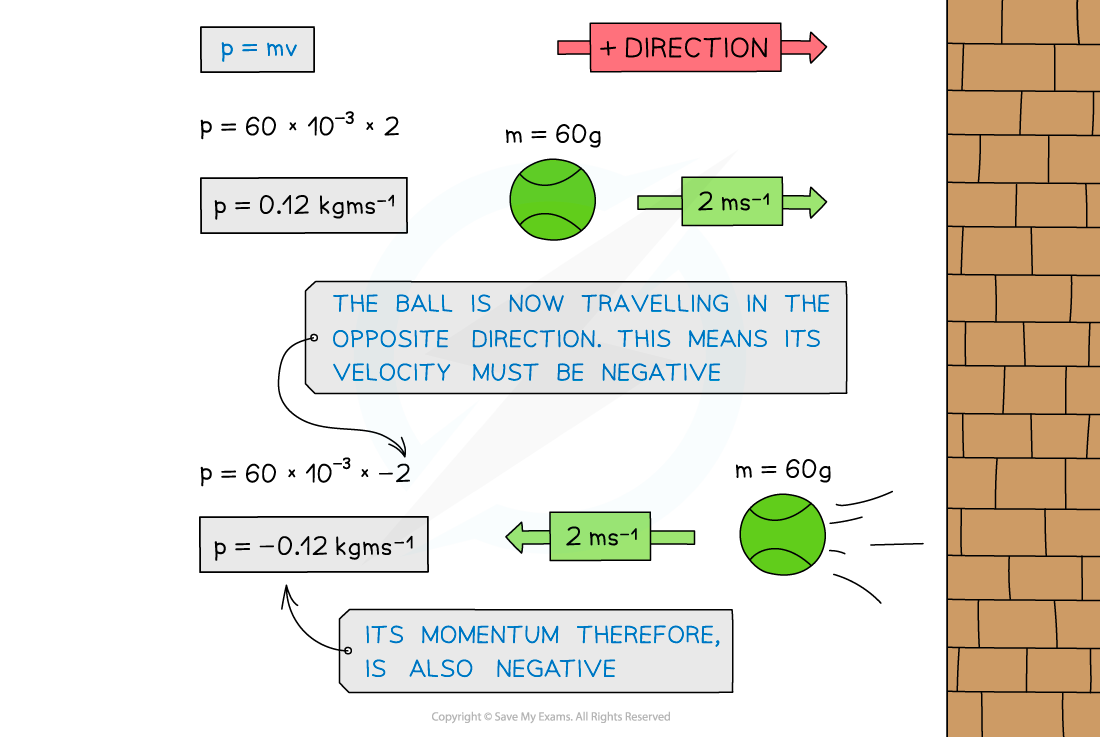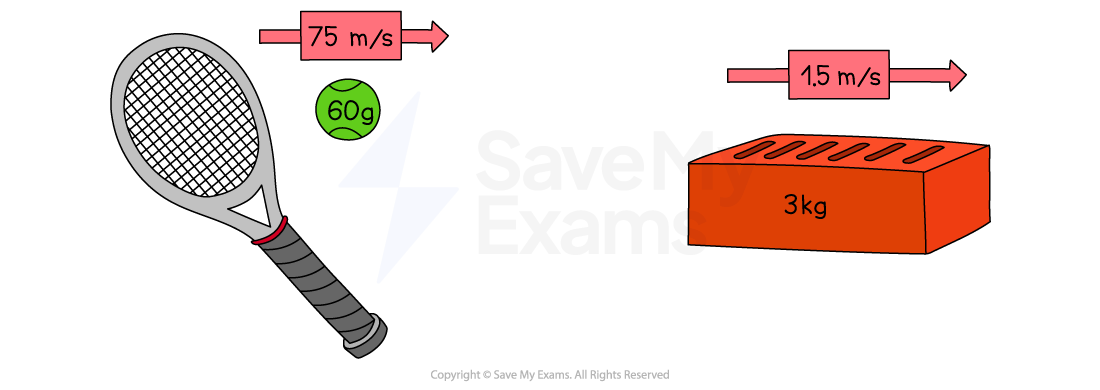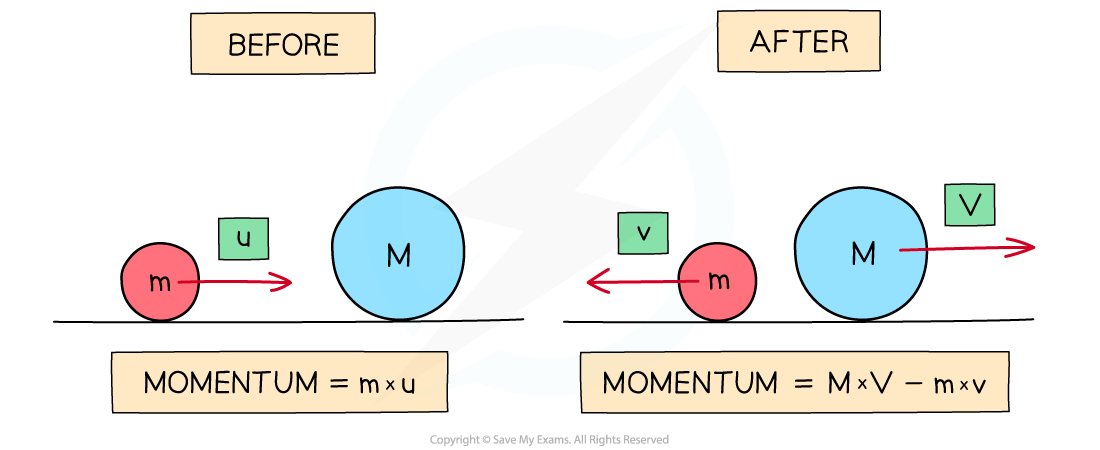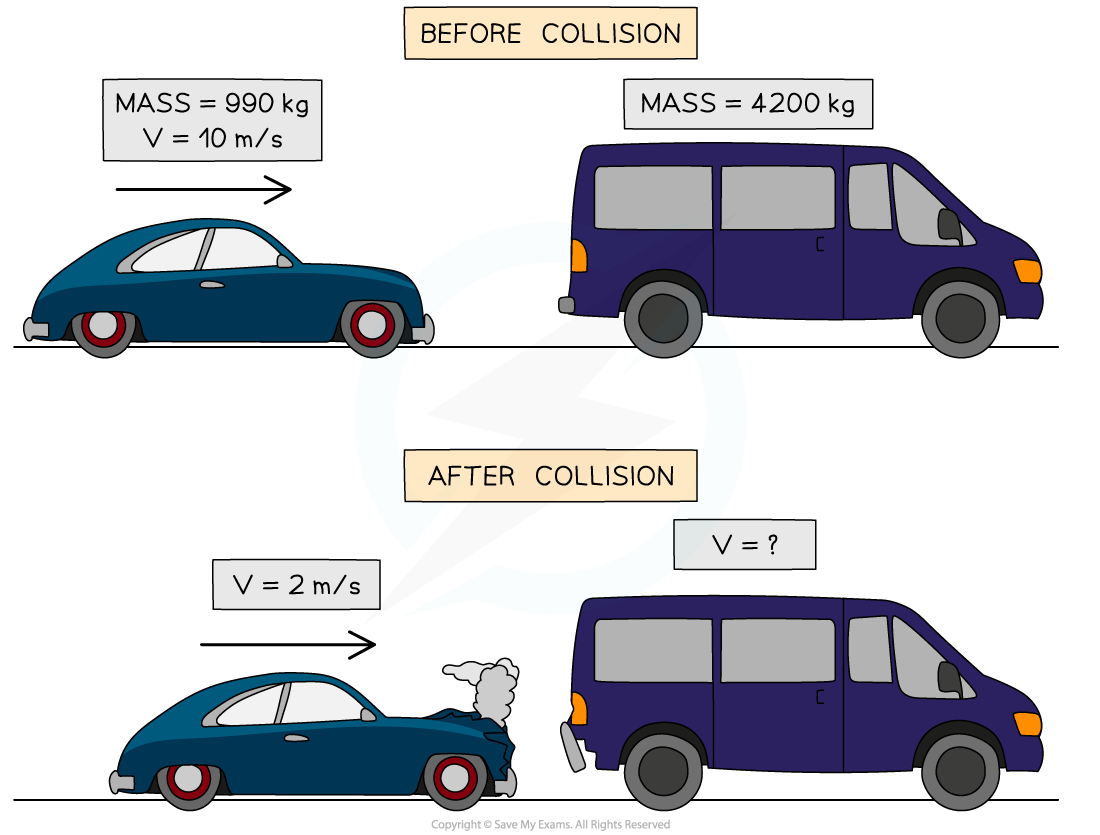Momentum (Edexcel IGCSE Physics): Revision Note
Exam code: 4PH1
Did this video help you?
Calculating momentum
Momentum is a property that all moving objects have
An object with mass,
, moving at a velocity,
, will have a momentum,
The momentum equation
Momentum is the product of an objects mass and velocity
Where:
p = momentum in kilogram metre per second (kg m/s)
m = mass in kilograms (kg)
v = velocity in metres per second (m/s)
This means that an object at rest (i.e. v = 0) has no momentum
Momentum keeps an object moving in the same direction
It is difficult to change the direction of an object with a large momentum
Velocity is a vector with both magnitude and direction
Therefore, the momentum of an object depends on its direction of travel
This means momentum can be either positive or negative
If an object travelling to the right has positive momentum, then an object travelling in the opposite direction (to the left) will have negative momentum
This isn't a solid rule, but in questions, usually the positive direction is to the right and negative to the left
How does the momentum of a ball change after a collision?

The momentum of the tennis ball is positive as it approaches the wall and negative after the collision as it moves in the opposite direction
The momentum of an object will change if:
it's velocity increases or decreases (acceleration)
it's direction changes (acceleration)
it's mass changes
Worked Example
Determine which object has the most momentum, the tennis ball or the brick.
Explain your answer.

Answer:
Step 1: Calculate the momentum of the tennis ball using the momentum equation
p = mv
p = 0.06 × 75
p = 4.5 kg m/s
Step 2: Calculate the momentum of the brick using the momentum equation
p = mv
p = 3 × 1.5
p = 4.5 kg m/s
Step 3: Explain your answer
Both the tennis ball and the brick have the same momentum
Even though the brick has a much greater mass than the ball, the ball is travelling much faster than the brick
This means that on impact, they would both exert a similar force (depending on the time it takes for each to come to rest)
Examiner Tips and Tricks
Remember the units of momentum as kg m/s which is the product of the units of mass (kg) and velocity (m/s).
Which direction is taken as positive is completely up to you in the exam. In general, forwards, to the right, and upwards are taken as positive, and backward, to the left, or down are taken as negative.
Conservation of momentum
The principle of conservation of momentum
The principle of conservation of momentum states that:
The total momentum before an interaction is equal to the total momentum after an interaction, if no external forces are acting on the objects
In this context, an interaction can be either:
A collision i.e. where two objects collide with each other
An explosion i.e. where a stationary object explodes into two (or more) parts
Collisions
For a collision between two objects:
The total momentum before a collision = the total momentum after a collision
In the example below:
Before the collision:
The momentum is only generated by mass m because it is the only moving object
If the right is taken as the positive direction, the total momentum of the system is m × u
After the collision:
Mass M also now has momentum
The velocity of m is now -v (since it is now travelling to the left) and the velocity of M is V
The total momentum is now the momentum of M + the momentum of m
This is (M × V) + (m × -v) or (M × V) – (m × v) written more simply
Conservation of momentum before and after a collision

The momentum of a system before and after a collision is always conserved
Since momentum is a vector quantity, a system of objects moving in opposite directions (e.g. towards each other) at the same speed will have an overall momentum of 0 since they will cancel out
Momentum is always conserved over time
Worked Example
The diagram shows a car and a van, just before and after the car collides with the van, which is initially at rest.
The car initially moves at a speed of 10 m/s, but this reduces to 2 m/s after the collision.

The mass of the car is 990 kg and the mass of the van is 4200 kg.
Calculate the velocity of the van when it is pushed forward by the collision.
Answer:
Step 1: State the principle of the conservation of momentum
Total momentum before a collision = total momentum after a collision
Step 2: Calculate the total momentum of the car and van before the collision
Momentum: p = mv
Initial momentum of the car:
pcar = 990 × 10 = 9900 kgm/s
Initial momentum of the van:
pvan = 0 (the van is at rest, so p = v = 0)
Total momentum before collision:
pbefore = pcar + pvan
pbefore = 9900 + 0 = 9900 kg m/s
Step 3: Calculate the total momentum of the car and van after the collision
Final momentum of the car:
pcar = 990 × 2 = 1980 kg m/s
Final momentum of the van:
pvan = 4200 × v
Total momentum after collision:
pafter = 1980 + 4200v
Step 4: Rearrange the conservation of momentum equation for the velocity of the van
pbefore = pafter
9900 = 1980 + 4200v
9900 − 1980 = 4200v
= 1.9 m/s
Examiner Tips and Tricks
If it is not given in the question already, drawing a diagram of before and after helps keep track of all the masses and velocities (and directions) in the conservation of momentum questions.
Remember that velocity is speed with a direction. The question asks for the speed, so you do not need to include the final speed in your answer.

Unlock more, it's free!
Did this page help you?